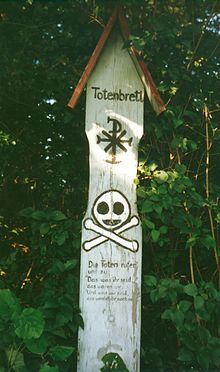Death board


Wooden boards on which the dead were laid out until burial and placed by the wayside in memory of the deceased are referred to as death boards (corpse boards , reeds or racks) .
distribution
This custom was widespread in the entire Bavarian and Alemannic region in the 19th century . It is also occupied for the Lower Rhine .
Today death boards can only be found in the Bavarian Forest and the Upper Palatinate Forest, as well as island-like between Lech and Ammersee , in the districts of Fürstenfeldbruck and Landsberg and finally in Chiemau and Traungau and in Rupertiwinkel . On the Lower Rhine, the Eyller Chapel in the Kleve district still houses many specimens.
development
In Bavaria, the burial of the dead in coffins was around the 17th / 18th centuries. Introduced in the 19th century. Before this time, the deceased were laid out on boards in the living room and carried to their grave on them. The boards were either buried with the corpse wrapped in a linen cloth, burned or kept for further deaths.
In the Bavarian Forest and in the Upper Palatinate area, the custom developed to set up the board (with a dedication) as a death board. The memorial inscription only developed over time. At first only three crosses were carved, burned, drawn or painted on the wood. More detailed texts and poems in praise of the deceased are found later. More or less elaborate carvings and colored paintings only became common from the middle of the 19th century.
Presumably, the death boards were originally placed horizontally. This form can still be seen in some places in the Upper Palatinate . Later the boards were set up vertically. This change in customs took place from south to north.
At times it was forbidden to put up death boards.
Today the tradition is continued. However, the dead are no longer laid out on these boards beforehand.
The following is known for the Lower Rhine: Immediately after the death of a relative, a black death board was placed on the outside next to the front door as a so-called pointing board. A white cross with a skull and two crossed bones were painted on it as a sign of impermanence. Depending on the area, the death board could have different functions. First, the deceased was laid out on it and transported to the burial site. Then it was used as a burial board on which the deceased was placed in the grave. Another use was in the board as an announcement and pointing board, as it is e.g. B. was the case in Uerdingen . After the burial, the death board was kept in a chapel. There it served as a memorial board for the deceased.
Popular belief
The increasingly artistic design of the boards in the 19th century represented a departure from the originally widespread popular belief. This said that the soul of the deceased only finds redemption when his death board had fallen into disrepair. In order to achieve the shortest possible time in purgatory , the older death boards were therefore made of softwood and exposed to the elements without protection. Occasionally there are reports of death boards that were used as step planks or walkways.
Memorial boards

“The dead call out to us:
'What you are,
we were.
And what we are,
you will still be. '"
In addition to the “real” death boards with a length of up to 2 m and a width of 40 cm - especially in southeastern Upper Bavaria (Chiemgau, Rupertiwinkel) - the custom has developed to set up shorter, narrower memorial boards. These boards, which are rarely more than 150 cm long and 30 cm wide, are also placed on the side of the road. On them there are meaning and memorial sayings, which however do not remind of a specific person, but generally call for remembrance of the dead.
In the Bavarian Forest there are also pure memorial boards, but they also remind of specific dead.
See also
literature
- Reinhard Haller: death boards. Custom monuments in Lower Bavaria and the Upper Palatinate. New finds on an old subject. Morsak Verlag, Grafenau 1990, ISBN 3-87553-362-3 .
- Walter Hartinger: The death board. Considerations on the nomenclature and genesis of a custom. In: Yearbook for Folklore. 6, 1982, pp. 126-148.
- Walter Hartinger: Death Boards in the Bavarian Forest and Bohemian Forest. Considerations about their creation and function . In East Bavarian border marks. 32, 1990, ISSN 0078-6845 , pp. 123-138.
- Walter Hartinger: Religion and Custom. Scientific Book Society, Darmstadt 1992, ISBN 3-5341090-0-7 .
- Günther Kampfhammer: Custom. In: Hejo Busly, Toni Drexler, Carl A. Hoffmann, Paul-E. Salzmann, Klaus Wollemann (ed.): The district of Fürstenfeldbruck. Nature - history - culture. District Office, Fürstenfeldbruck 1992, ISBN 3-9803189-0-7 .
- Hans Roth : Evidence of the commemoration of the dead in the landscape. In: Sigrid Metken (Ed.): The last journey. Dying, death and mourning customs in Upper Bavaria. Hugendubel, Munich 1984, ISBN 3-88034-247-4 (exhibition catalog, Munich, Stadtmuseum, July 4 to September 9, 1984).


